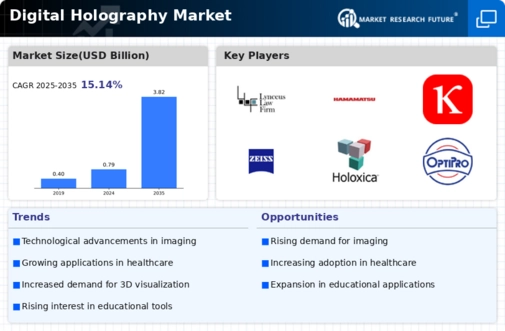Top Industry Leaders in the Digital Holography Market

Competitive Landscape of the Digital Holography Market
The digital holography market is a captivating realm where science fiction merges with tangible applications. This burgeoning market, driven by the allure of creating 3D visuals without physical objects, is witnessing a dynamic and intricate competitive landscape. Let's delve into the strategies of market leaders, key factors for market share analysis, emerging players, and the overall competitive scenario.
Key Player:
- Lyncee Tec SA
- Zebra Imaging Inc.
- Eon Reality, Inc.
- Geola Digital lab.
- Holoxica Ltd.
- RealView Imaging Ltd.
- Light Logics Holography and Optics Pvt Ltd
- Jasper Display Corporation
Strategies Adopted by Leaders:
- Technology Prowess: Microsoft and Looking Glass Factory lead the charge with high-resolution holographic displays and sophisticated software, setting the benchmark for visual fidelity and user experience.
- Vertical Specialization: HoloTech Studios targets the entertainment industry with interactive holographic displays for live events and theme parks, demonstrating the value of catering to specific needs.
- Partnership Play: Sony collaborates with universities and research institutions to develop advanced materials and algorithms for holographic displays, fostering co-development and market access.
- Open-Source Platforms: Holoverse offers open-source software tools for creating and manipulating holograms, empowering developers and accelerating innovation in the ecosystem.
- Content Creation Focus: Realview Imaging Ltd. invests in producing 3D content libraries specifically formatted for holographic displays, addressing the content deficit in the market.
Factors for Market Share Analysis:
- Technological Leadership: Companies offering superior resolution, wider viewing angles, and improved depth perception in their holographic displays command premium prices and secure market share.
- Content Availability and Ecosystem Development: Access to or creation of compelling 3D content for various applications like product design, education, and medical visualizations is crucial for market adoption.
- Cost Competitiveness: Balancing affordability with performance is paramount for winning tenders in price-sensitive segments, particularly in emerging markets.
- Integration with Existing Infrastructure: Seamless integration with existing IT systems and display technologies enhances compatibility and facilitates wider adoption.
- Regulatory Landscape: Navigating and adhering to complex regulations surrounding laser safety and potential health impacts of prolonged exposure to holographic displays is crucial for market access and compliance.
New and Emerging Companies:
- Startups like ArhtBox and LightField Lab: These innovators focus on niche applications like holographic portraits and interactive art installations, catering to specific aesthetic needs and artistic expression.
- Academia and Research Labs: MIT Media Lab and Stanford University's Nano Research Laboratory explore novel materials and techniques for holographic displays, like metamaterials and bio-inspired components, shaping the future of technology.
- Component Manufacturers: Companies like Corning and 3M invest in developing advanced materials for display surfaces and light-manipulating films, influencing core technologies and affordability in the market.
Industry Developments:
Holoeye Photonics AG:
- Dec 2023: Launched LeiaDisplay Pro, a high-resolution holographic display for professional applications and virtual reality experiences.
- Oct 2023: Introduced LeiaLight L1, a portable holographic projector for interactive displays and product demonstrations.
Lyncee Tec.:
- Nov 2023: Partnered with a medical research institute to develop holographic microscopy platform for cancer cell analysis.
- Jul 2023: Secured funding to expand its production capacity and commercialize its holographic imaging systems for industrial applications.
